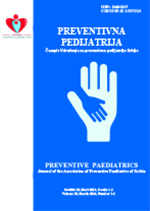AN OVERVIEW OF NEUROPROTECTIVE STRATEGIES IN PRETERM NEONATES
DOI:
https://doi.org/10.46793/PP241127001PKeywords:
prematurity, preterm newborn, neurodevelopmental disabilities, neuroprotection, brain injuryAbstract
With advances in antenatal and neonatal therapy and care, the survival of preterm neonates, especially extremely immature, has increased. Brain injury occurs significantly more often in preterm neonates compared to full-term neonates, which is associated with a higher risk of neurodevelopmental disorders. Three common and frequent forms of preterm brain injury are intraventricular hemorrhage, white and gray matter injury. There are numerous antenatal, intrapartum and postnatal strategies in order to reduce risk of preterm brain injury and poor neurodevelopmental outcome. First of all, studies showed that antenatal corticosteroid and magnesium sulfate administration in case of threatened preterm delivery has an importance role in reducing the risk for preterm brain injury and neurodevelopmental disabilities. Also, delayed cord clamping and many interventions in early neonatal period, such as maintenance of optimal ventilation and hemodynamic stability, blood glucose monitoring concentration, recognition of neonatal seizures and administration of anti-seizure medications, use of caffeine and optimal nutrition affect the improvement of the neurological development of the preterm neonates. At the end of the 20th century, a special program for the care and assessment of the behavior of neonates, Neonatal Individualized Developmental Care and Assessment Program, was developed, which is used today in many neonatal intensive care units in order to minimize developmental delays of preterm neonates. A number of drugs and interventions whose possible neuroprotective effects are being investigated include mild hypothermia, erythropoietin, melatonin, allopurinol, stem cell therapy, maternal vitamin D supplementation during pregnancy, exosomal-based therapy, et al.
References
March of Dimes, PMNCH, Save the Children, WHO. Born Too Soon: The Global Action Report on Preterm Birth. Eds CP Howson, MV Kinney, Je Lawn. World Health Organization. Geneva, 2012.
Molloy EJ, El-Dib M, Soul J, Juul S, Gunn AJ, Bender M, et al. Neuroprotective therapies in the NICU in preterm infants: present and future (Neonatal Neurocritical Care Series). Pediatr Res. 2024;95(5):1224-12236. doi: 10.1038/s41390-023-02895-6. PMID: 38114609.
Parikh P, Juul SE. Neuroprotection Strategies in Preterm Encephalopathy. Semin Pediatr Neurol. 2019;32:100772. doi: 10.1016/j.spen.2019.08.008. PMID: 31813513.
Volpe JJ, Inder TE, Darras BT, de Vries LS, du Plessis AJ, Ferriero DM, et al. Volpe’s Neurology of the Newborn. 7th ed. Philaderlphia: Elsevier; 2024.
Siahanidou T, Spiliopoulou C. Pharmacological Neuroprotection of the Preterm Brain: Current Evidence and Perspectives. Am J Perinatol. 2022;39(5):479-491. doi: 10.1055/s-0040-1716710. PMID: 32961562.
Volpe JJ. Brain injury in premature infants: a complex amalgam of destructive and developmental disturbances. Lancet Neurol. 2009;8(1):110-124. doi: 10.1016/S1474-4422(08)70294-1. PMID: 19081519.
Yates N, Gunn AJ, Bennet L, Dhillon SK, Davidson JO. Preventing Brain Injury in the Preterm Infant-Current Controversies and Potential Therapies. Int J Mol Sci. 2021; 22(4):1671. doi: 10.3390/ijms22041671. PMID: 33562339.
Lien R. Neurocritical care of premature infants. Biomed J. 2020;43(3):259-267. doi: 10.1016/j.bj.2020.03.007. PMID: 32333994.
Juul SE, Natarajan N, Mietzsch U. Management of Encephalopathy of Prematurity. In: Maheshwari A, editor. Principles of Neonatology. Elsevier; 2023. p. 421-426.
McGoldrick E, Stewart F, Parker R, Dalziel SR. Antenatal corticosteroids for accelerating fetal lung maturation for women at risk of preterm birth. Cochrane Database Syst Rev. 2020;12(12):CD004454. doi: 10.1002/14651858.CD004454.pub4. PMID: 28321847.
Wang D, Ming L, Zhu Y. Antenatal corticosteroid administration-to-birth interval and neonatal outcomes in very preterm infants: A secondary analysis based on a prospective cohort study. PLoS One. 2023;18(2):e0281509. doi: 10.1371/journal.pone.0281509. PMID: 36763575.
McDougall ARA, Aboud L, Lavin T, Cao J, Dore G, Ramson J, et al. Effect of antenatal corticosteroid administration-to-birth interval on maternal and newborn outcomes: a systematic review. EClinicalMedicine. 2023;58:101916. doi: 10.1016/j.eclinm.2023.101916. PMID: 37007738.
Sweet DG, Carnielli VP, Greisen G, Hallman M, Klebermass-Schrehof K, Ozek E, et al. European Consensus Guidelines on the Management of Respiratory Distress Syndrome: 2022 Update. Neonatology. 2023;120(1):3-23. doi: 10.1159/000528914. PMID: 36863329.
Crowther CA, Middleton PF, Voysey M, Askie L, Zhang S, Martlow TK, et al. Effects of repeat prenatal corticosteroids given to women at risk of preterm birth: An individual participant data meta-analysis. PLoS Med. 2019;16(4):e1002771. doi: 10.1371/journal.pmed.1002771. PMID:30978205.
Ayed M, Ahmed J, More K, Ayed A, Husain H, AlQurashi A, et al. Antenatal Magnesium Sulfate for Preterm Neuroprotection: A Single-Center Experience from Kuwait Tertiary NICU. Biomed Hub. 2022;7(2):80-87. doi: 10.1159/000525431. PMID: 35950015.
Bansal V, Desai A. Efficacy of Antenatal Magnesium Sulfate for Neuroprotection in Extreme Prematurity: A Comparative Observational Study. J Obstet Gynaecol India. 2022;72(Suppl 1):36-47. doi: 10.1007/s13224-021-01531-9. PMID: 34393393.
Shepherd ES, Goldsmith S, Doyle LW, Middleton P, Marret S, Rouse DJ, et al. Magnesium sulphate for women at risk of preterm birth for neuroprotection of the fetus. Cochrane Database Syst Rev. 2024;5(5):CD004661. doi: 10.1002/14651858.CD004661.pub4. PMID: 38726883.
Katheria AC, Reister F, Hummler H, Essers J, Mendler M, Truong G, et al. Premature infants receiving cord milking or delayed cord clamping: A randomized controlled non-inferiority trial (abstract LB 1). Am J Obstet Gynecol. 2019; 220(Suppl):S682. doi: 10.1016/j.ajog.2018.12.004.
Katheria A, Szychowski J, Carlo WA, Subramaniam A, Reister F, Essers J, et al. Umbilical Cord Milking Versus Delayed Cord Clamping in Infants 28 to 32 Weeks: A Randomized Trial. Pediatrics. 2023;152(6):e2023063113. doi: 10.1542/peds.2023-063113. PMID: 37941523.
Kapadia V, Oei JL, Finer N, Rich W, Rabi Y, Wright IM, et al. Outcomes of delivery room resuscitation of bradycardic preterm infants: A retrospective cohort study of randomised trials of high vs low initial oxygen concentration and an individual patient data analysis. Resuscitation. 2021;167:209-217. doi: 10.1016/j.resuscitation.2021.08.023. PMID: 34425156.
Sotiropoulos JX, Oei JL, Schmölzer GM, Libesman S, Hunter KE, Williams JG, et al. Initial Oxygen Concentration for the Resuscitation of Infants Born at Less Than 32 Weeks' Gestation: A Systematic Review and Individual Participant Data Network Meta-Analysis. JAMA Pediatr. 2024;178(8):774-783. doi: 10.1001/jamapediatrics.2024.1848. PMID: 38913382.
Synnes A, Grunau RE. Neurodevelopmental outcomes after neonatal caffeine therapy. Semin Fetal Neonatal Med. 2020;25(6):101160. doi: 10.1016/j.siny.2020.101160. PMID: 33121916.
Lodha A, Entz R, Synnes A, Creighton D, Yusuf K, Lapointe A, et al. Early Caffeine Administration and Neurodevelopmental Outcomes in Preterm Infants. Pediatrics. 2019;143(1):e20181348. doi: 10.1542/peds.2018-1348. PMID: 30518670.
Rozance PJ. Management and outcome of neonatal hypoglycemia. UpToDate. https://www.uptodate.com/contents/management-and-outcome-of-neonatal-hypoglycemia (Accessed November 20, 2024).
Ramel S, Rao R. Hyperglycemia in Extremely Preterm Infants. Neoreviews. 2020;21(2):e89-e97. doi: 10.1542/neo.21-2-e89. PMID: 32005719.
Rao LM, Marcuccilli CJ. Seizures in the Preterm Neonate. Neoreviews. 2017;18 (1):e52-e59. doi: 10.1542/neo.18-1-e52.
Ziobro J, Pilon B, Wusthoff CJ, Benedeti GM, Massey SL, Yozawitz E, et al. Neonatal Seizures: New Evidence, Classification, and Guidelines. Epilepsy Currents. 2024;0(0):1-8. doi: 10.1177/15357597241253382.
Wu TW, Azhibekov T, Seri I. Transitional Hemodynamics in Preterm Neonates: Clinical Relevance. Pediatr Neonatol. 2016;57(1):7-18. doi: 10.1016/j.pedneo.2015.07.002. PMID: 26482579.
El-Khuffash A, McNamara PJ. Hemodynamic Assessment and Monitoring of Premature Infants. Clin Perinatol. 2017;44(2):377-393. doi: 10.1016/j.clp.2017.02.001. PMID: 28477667.
Wu TW, Noori S. Recognition and management of neonatal hemodynamic compromise. Pediatr Neonatol. 2021;62 Suppl 1:S22-S29. doi: 10.1016/j.pedneo.2020.12.007. PMID: 33485823.
Mistry K, Gupta C. Neonatal Hypertension. Neoreviews. 2017;18(6):e357–e371. doi: 10.1542/neo.18-6-e357.
Moody C, Callahan TJ, Aldrich H, Gance-Cleveland B, Sables-Baus S. Early Initiation of Newborn Individualized Developmental Care and Assessment Program (NIDCAP) Reduces Length of Stay: A Quality Improvement Project. J Pediatr Nurs. 2017;32:59-63. doi: 10.1016/j.pedn.2016.11.001. PMID: 27923536





